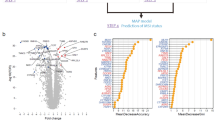Abstract
Recent molecular genetic studies have revealed that two major types of genomic instabilities, chromosomal instability (CIN) and microsatellite instability (MSI), exist in colorectal carcinomas. In order to clarify the molecular signature related to the CIN and MSI in colorectal carcinomas, we performed transcriptomic expression analysis on eight microsatellite instability-high (MSI-H) colorectal carcinomas and compared the results obtained with that of nine microsatellite stable (MSS) colorectal carcinomas using oligonucleotide microarrays containing 17 334 known genes and 1331 unknown genes or expression sequence tags (ESTs). Unsupervised two-way hierarchical clustering with 5724 genes successfully classified tumors from normal mucosa, and displayed a distinctive MSI-H carcinomas subgroup. Based on intensive filtering, 57 known genes and eight ESTs were found to be highly relevant to the differentiation of MSI-H and MSS colorectal carcinomas. These genes successfully distinguish the new test set of six MSI-H and five MSS colorectal carcinomas. Many up- and downregulated genes in MSI-H colorectal carcinomas were related to the previously reported phenotypic characteristics; increased mucin production and intense peritumoral immune response in MSI-H carcinomas. Some of these differences were confirmed by semiquantitative reverse transcription–PCR and immunohistochemical analysis. Our findings indicate that there are many different genetic and transcriptomic characteristics between MSI-H and MSS colorectal carcinomas, and some of these differently expressed genes can be used as diagnostic or prognostic markers.
This is a preview of subscription content, access via your institution
Access options
Subscribe to this journal
Receive 50 print issues and online access
$259.00 per year
only $5.18 per issue
Buy this article
- Purchase on Springer Link
- Instant access to full article PDF
Prices may be subject to local taxes which are calculated during checkout


Similar content being viewed by others
References
Alexander J, Watanabe T, Wu TT, Rashid A, Li S and Hamilton SR . (2001). Am. J. Pathol., 158, 527–535.
Alon U, Barkai N, Notterman DA, Gish K, Ybarra S, Mack D and Levine AJ . (1999). Proc. Natl. Acad. Sci. USA, 96, 6745–6750.
Bertucci F, Salas S, Eysteries S, Nasser V, Finetti P, Ginestier C, Charafe-Jauffret E, Loriod B, Bachelart L, Montfort J, Victorero G, Viret F, Ollendorff V, Fert V, Giovaninni M, Delpero JR, Nguyen C, Viens P, Monges G, Birnbaum D and Houlgatte R . (2004). Oncogene, 23, 1377–1391.
Biemer-Huttmann AE, Walsh MD, McGuckin MA, Simms LA, Young J Leggett BA and Jass JR . (2000). Clin. Cancer Res., 6, 1909–1916.
Birkenkamp-Demtroder K, Christensen LL, Olesen SH, Frederiksen CM, Laiho P, Aaltonen LA, Laurberg S, Sorensen FB, Hagemann R and Orntoft TF . (2002). Cancer Res., 62, 4352–4363.
Cormier RT, Hong KH, Halberg RB, Hawkins TL, Richardson P, Mulherkar R, Dove WF and Lander E . (1997). Nat. Genet., 17, 88–91.
DeRisi JL, Iyer VR and Brown PO . (1997). Science, 278, 680–686.
Dunican DS, McWilliam P, Tighe O, Parle-McDermott A and Croke DT . (2002). Oncogene, 21, 3253–3257.
Duval A and Hamelin R . (2002). Cancer Res., 62, 2447–2454.
Guidoboni M, Gafa R, Viel A, Doglioni C, Russo A, Santini A, Del Tin L, Macri E, Lanza G, Boiocchi M and Dolcetti R . (2001). Am. J. Pathol., 159, 297–304.
Hiraga Y, Tanaka S, Haruma K, Yoshihara M, Sumii K, Kajiyama G, Shimamoto F and Kohno N . (1998). Oncology, 55, 307–319.
Ikeda S, Kishida S, Yamamoto H, Murai H, Koyama S and Kikuchi A . (1998). EMBO J., 17, 1371–1384.
Ionov Y, Peinado MA, Malkhosyan S, Shibata D and Perucho M . (1993). Nature, 363, 558–561.
Kim H, Jen J, Vogelstein B and Hamilton SR . (1994). Am. J. Pathol., 145, 148–156.
Kim N-G., Choi YR, Baek MJ, Kim YH, Kang H, Kim NK, Min JS and Kim H . (2001). Cancer Res., 61, 36–38.
Kim N-G, Rhee H, Li LS, Kim H, Lee JS, Kim JH, Kim NK and Kim H . (2002). Oncogene, 21, 5081–5087.
Kinzler KW and Vogelstein B . (1996). Cell, 87, 159–170.
Kitahara O, Furukawa Y, Tanaka T, Kihara C, Ono K, Yanagawa R, Nita M E, Takagi T, Nakamura Y and Tsunoda T . (2001). Cancer Res., 61, 3544–3549.
Lengauer C, Kinzler KW and Vogelstein B . (1998). Nature, 396, 643–649.
Leung JY, Kolligs FT, Wu R, Zhai Y, Kuick R, Hanash S, Cho KR and Fearon ER . (2002). J. Biol. Chem., 277, 21657–21665.
MacPhee M, Chepenik KP, Liddell RA, Nelson KK, Siracusa LD and Buchberg AM . (1995). Cell, 81, 957–966.
Mori Y, Selaru FM, Sato F, Yin J, Simms LA, Xu Y, Olaru A, Deacu E, Wang S, Taylor JM, Young J, Leggett B, Jass JR, Abraham JM, Shibata D and Meltzer SJ . (2003). Cancer Res., 63, 4577–4582.
Notterman DA, Alon U, Sierk AJ and Levine AJ . (2001). Cancer Res., 61, 3124–3130.
Stenger S, Rosat JP, Bloom BR, Krensky AM and Modlin RL . (1999). Immunol. Today, 20, 390–394.
Thibodeau SN, Bren G and Schaid D . (1993). Science, 260, 816–819.
Ward R, Meagher A, Tomlinson I, O'Connor T, Norrie M, Wu R and Hawkins N . (2001). Gut, 48, 821–829.
Acknowledgements
This study was supported by a grant of the Korea Health 21 R&D Project, Ministry of Health & Welfare, Republic of Korea (03-PJ10-PG6-GP01-0002) and the Cancer Metastasis Research Center at Yonsei University.
Author information
Authors and Affiliations
Corresponding author
Additional information
Supplementary Information accompanies the paper on Oncogene website (http://www.nature.com/onc).
Supplementary information
Rights and permissions
About this article
Cite this article
Kim, H., Nam, S., Rhee, H. et al. Different gene expression profiles between microsatellite instability-high and microsatellite stable colorectal carcinomas. Oncogene 23, 6218–6225 (2004). https://doi.org/10.1038/sj.onc.1207853
Received:
Revised:
Accepted:
Published:
Issue Date:
DOI: https://doi.org/10.1038/sj.onc.1207853
Keywords
This article is cited by
-
Familial colorectal cancer type X: genetic profiles and phenotypic features
Modern Pathology (2015)



